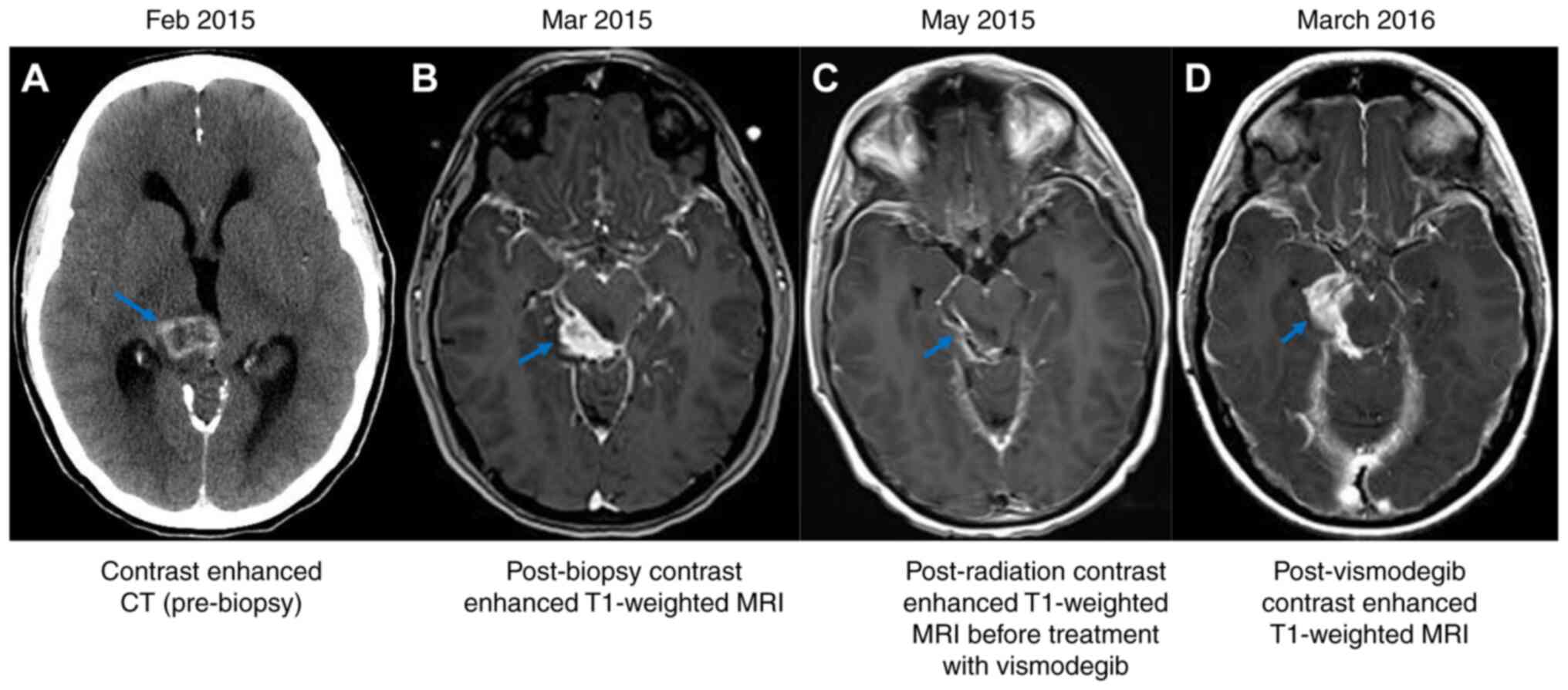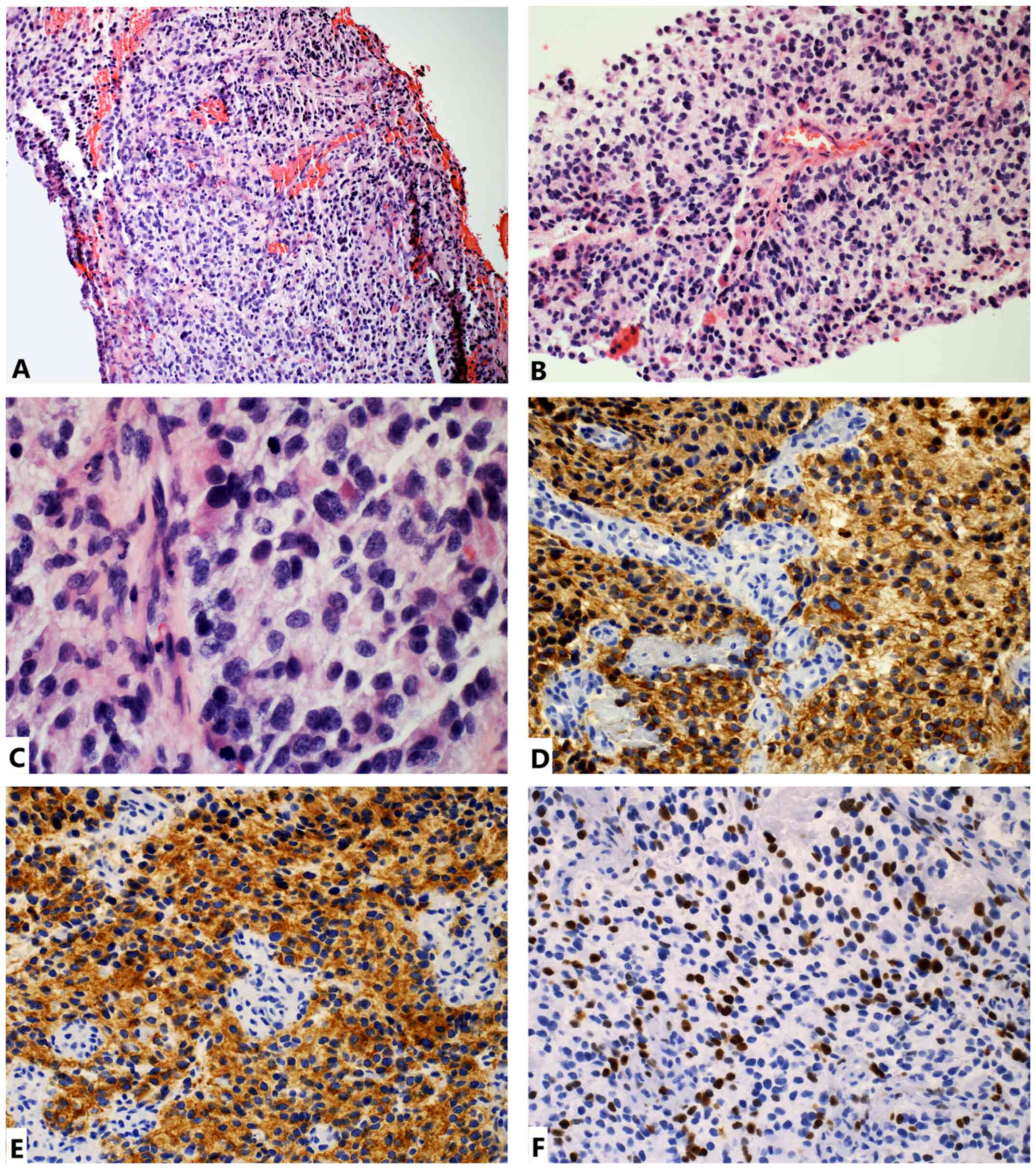|
1
|
Gorlin RJ and Goltz RW: Multiple nevoid
basal-cell epithelioma, jaw cysts and bifid rib. A syndrome. N Engl
J Med. 262:908–912. 1960. View Article : Google Scholar : PubMed/NCBI
|
|
2
|
Mortimer PS, Geaney DP, Liddell K and
Dawber RP: Basal cell naevus syndrome and intracranial meningioma.
J Neurol Neurosurg Psychiatry. 47:210–212. 1984. View Article : Google Scholar : PubMed/NCBI
|
|
3
|
Gorlin Syndrome-Genetics Home
Reference-NIH, . [11/9/21]. Available from. https://ghr.nlm.nih.gov/condition/gorlin-syndrome
|
|
4
|
Lo Muzio L, Nocini PF, Savoia A, Consolo
U, Procaccini M, Zelante L, Pannone G, Bucci P, Dolci M, Bambini F,
et al: Nevoid basal cell carcinoma syndrome. Clinical findings in
37 Italian affected individuals. Clin Genet. 55:34–40. 1999.
View Article : Google Scholar : PubMed/NCBI
|
|
5
|
Lo Muzio L: Nevoid basal cell carcinoma
syndrome (Gorlin syndrome). Orphanet J Rare Dis. 3:322008.
View Article : Google Scholar : PubMed/NCBI
|
|
6
|
Gorlin RJ: Nevoid basal cell carcinoma
syndrome. Dermatol Clin. 13:113–125. 1995. View Article : Google Scholar : PubMed/NCBI
|
|
7
|
Anderson DE, Taylor WB, Falls HF and
Davidson RT: The nevoid basal cell carcinoma syndrome. Am J Hum
Genet. 19:12–22. 1967.PubMed/NCBI
|
|
8
|
Smith MJ, Beetz C, Williams SG, Bhaskar
SS, O'Sullivan J, Anderson B, Daly SB, Urquhart JE, Bholah Z, Oudit
D, et al: Germline mutations in SUFU cause Gorlin
syndrome-associated childhood medulloblastoma and redefine the risk
associated with PTCH1 mutations. J Clin Oncol. 32:4155–4161. 2014.
View Article : Google Scholar : PubMed/NCBI
|
|
9
|
Gururangan S, Robinson G, Ellison DW, Wu
G, He X, Lu QR, McLendon R, Grant G, Driscoll T and Neuberg R:
Gorlin syndrome and desmoplastic medulloblastoma: Report of 3 cases
with unfavorable clinical course and novel mutations. Pediatr Blood
Cancer. 62:1855–1858. 2015. View Article : Google Scholar : PubMed/NCBI
|
|
10
|
Evans DG, Ladusans EJ, Rimmer S, Burnell
LD, Thakker N and Farndon PA: Complications of the naevoid basal
cell carcinoma syndrome: Results of a population based study. J Med
Genet. 30:460–464. 1993. View Article : Google Scholar : PubMed/NCBI
|
|
11
|
Choudry Q, Patel HC, Gurusinghe NT and
Evans DG: Radiation-induced brain tumours in nevoid basal cell
carcinoma syndrome: Implications for treatment and surveillance.
Childs Nerv Syst. 23:133–136. 2007. View Article : Google Scholar : PubMed/NCBI
|
|
12
|
Donev K, Scheithauer BW, Rodriguez FJ and
Jenkins S: Expression of diagnostic neuronal markers and outcome in
glioblastoma. Neuropathol Appl Neurobiol. 36:411–421. 2010.
View Article : Google Scholar : PubMed/NCBI
|
|
13
|
Frampton GM, Fichtenholtz A, Otto GA, Wang
K, Downing SR, He J, Schnall-Levin M, White J, Sanford EM, An P, et
al: Development and validation of a clinical cancer genomic
profiling test based on massively parallel DNA sequencing. Nat
Biotechnol. 31:1023–1031. 2013. View
Article : Google Scholar : PubMed/NCBI
|
|
14
|
Di Stefano AL, Fucci A, Frattini V,
Labussiere M, Mokhtari K, Zoppoli P, Marie Y, Bruno A, Boisselier
B, Giry M, et al: Detection, Characterization, and Inhibition of
FGFR-TACC Fusions in IDH Wild-type Glioma. Clin Cancer Res.
21:3307–3317. 2015. View Article : Google Scholar : PubMed/NCBI
|
|
15
|
Murone M, Rosenthal A and de Sauvage FJ:
Hedgehog signal transduction: From flies to vertebrates. Exp Cell
Res. 253:25–33. 1999. View Article : Google Scholar : PubMed/NCBI
|
|
16
|
Hahn H, Wicking C, Zaphiropoulous PG,
Gailani MR, Shanley S, Chidambaram A, Vorechovsky I, Holmberg E,
Unden AB, Gillies S, et al: Mutations of the human homolog of
Drosophila patched in the nevoid basal cell carcinoma syndrome.
Cell. 85:841–851. 1996. View Article : Google Scholar : PubMed/NCBI
|
|
17
|
Onodera S, Nakamura Y and Azuma T: Gorlin
Syndrome: Recent advances in genetic testing and molecular and
cellular biological research. Int J Mol Sci. 21:75592020.
View Article : Google Scholar : PubMed/NCBI
|
|
18
|
Skoda AM, Simovic D, Karin V, Kardum V,
Vranic S and Serman L: The role of the Hedgehog signaling pathway
in cancer: A comprehensive review. Bosn J Basic Med Sci. 18:8–20.
2018. View Article : Google Scholar : PubMed/NCBI
|
|
19
|
Sasai N, Toriyama M and Kondo T: Hedgehog
signal and genetic disorders. Front Genet. 10:11032019. View Article : Google Scholar : PubMed/NCBI
|
|
20
|
Dessaud E, Yang LL, Hill K, Cox B, Ulloa
F, Ribeiro A, Mynett A, Novitch BG and Briscoe J: Interpretation of
the sonic hedgehog morphogen gradient by a temporal adaptation
mechanism. Nature. 450:717–720. 2007. View Article : Google Scholar : PubMed/NCBI
|
|
21
|
Cohen M, Kicheva A, Ribeiro A, Blassberg
R, Page KM, Barnes CP and Briscoe J: Ptch1 and Gli regulate Shh
signalling dynamics via multiple mechanisms. Nat Commun.
6:67092015. View Article : Google Scholar : PubMed/NCBI
|
|
22
|
AACR Project GENIE Consortium, . AACR
Project GENIE: Powering precision medicine through an International
consortium. Cancer Discov. 7:818–831. 2017. View Article : Google Scholar : PubMed/NCBI
|
|
23
|
Chandra V, Das T, Gulati P, Biswas NK,
Rote S, Chatterjee U, Ghosh SN, Deb S, Saha SK, Chowdhury AK, et
al: Hedgehog signaling pathway is active in GBM with GLI1 mRNA
expression showing a single continuous distribution rather than
discrete high/low clusters. PLoS One. 10:e01163902015. View Article : Google Scholar : PubMed/NCBI
|
|
24
|
Cerami E, Gao J, Dogrusoz U, Gross BE,
Sumer SO, Aksoy BA, Jacobsen A, Byrne CJ, Heuer ML, Larsson E, et
al: The cBio cancer genomics portal: An open platform for exploring
multidimensional cancer genomics data. Cancer Discov. 2:401–404.
2012. View Article : Google Scholar : PubMed/NCBI
|
|
25
|
Rohner A, Spilker ME, Lam JL, Pascual B,
Bartkowski D, Li QJ, Yang AH, Stevens G, Xu M, Wells PA, et al:
Effective targeting of Hedgehog signaling in a medulloblastoma
model with PF-5274857, a potent and selective Smoothened antagonist
that penetrates the blood-brain barrier. Mol Cancer Ther. 11:57–65.
2012. View Article : Google Scholar : PubMed/NCBI
|
|
26
|
Filbin MG, Dabral SK, Pazyra-Murphy MF,
Ramkissoon S, Kung AL, Pak E, Chung J, Theisen MA, Sun Y,
Franchetti Y, et al: Coordinate activation of Shh and PI3K
signaling in PTEN-deficient glioblastoma: New therapeutic
opportunities. Nat Med. 19:1518–1523. 2013. View Article : Google Scholar : PubMed/NCBI
|
|
27
|
Gajjar A, Stewart CF, Ellison DW, Kaste S,
Kun LE, Packer RJ, Goldman S, Chintagumpala M, Wallace D, Takebe N,
et al: Phase I study of vismodegib in children with recurrent or
refractory medulloblastoma: A pediatric brain tumor consortium
study. Clin Cancer Res. 19:6305–6312. 2013. View Article : Google Scholar : PubMed/NCBI
|
|
28
|
Robinson GW, Orr BA, Wu G, Gururangan S,
Lin T, Qaddoumi I, Packer RJ, Goldman S, Prados MD, Desjardins A,
et al: Vismodegib exerts targeted efficacy against recurrent sonic
hedgehog-subgroup medulloblastoma: Results from phase II pediatric
brain tumor consortium studies PBTC-025B and PBTC-032. J Clin
Oncol. 33:2646–2654. 2015. View Article : Google Scholar : PubMed/NCBI
|
|
29
|
Sloan AE, Nock CJ, Ye X, Kerstetter A,
Supko J, Rich KLN, Miller R, Takebe N, Prados M and Grossman SA:
Targeting glioma-initiating cells in GBM: ABTC-0904, a randomized
phase 0/II study targeting the Sonic Hedgehog-signaling pathway. J
Clin Oncol. 32 (Suppl 15):S20262014. View Article : Google Scholar
|
















